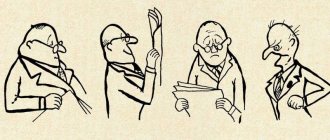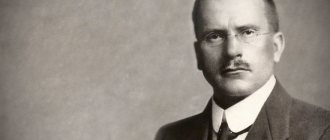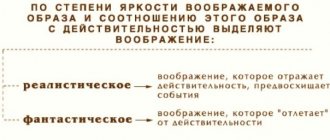Carl Gustav Jung is without a doubt an important name if we want to understand the history of psychology. His theories have been a source of both controversy and inspiration. It is not surprising that he is the founder of his own school of thought in the psychoanalytic field, the school of analytical psychology, also called complex and deep psychology.
For a long time, Jung was a student of Freud. However, he distanced himself from Freud mainly because he disagreed with his theory of sexuality. Moreover, Jung postulated the existence of a “collective unconscious” that precedes the individual unconscious.
“I know what I want: I have goals and opinions. Let me be myself, that's more than enough for me."
— Anne Frank
Jung was a restless intellectual who collected information from a variety of sources. In addition to neuroscience and psychoanalysis, Jung's theories were influenced by mythology, religion, and even parapsychology. One of his great interests was archeology, and this was probably his theory of archetypes. The theory of universal symbols present in the unconscious human mind.
Jung's personality type theory
For Carl Jung there are four basic psychological functions: thinking, believing, feeling and perceiving. In each person one or more of these functions have a special emphasis. For example, when someone is impulsive, according to Jung, it is because their “feeling and perceiving” functions take precedence over their “thinking and believing” functions.
Based on these four basic functions, Jung postulated that there are two basic character types: introvert and extrovert. Each has its own characteristics that distinguish it from the other.
Classification criteria
Jung's typology implies a psychological attitude according to which there are two types of people - extroverts and introverts. According to this teaching, the predominant mental functions are intuition, thinking, sensations, and feelings.
This typology was first presented in the work “Psychological Types,” written by Swiss psychiatrist Carl Gustave Jung in 1921. The purpose of the classification he developed was not to trivially divide people into separate groups according to any psychological characteristics. He wanted to create a special tool for a practical psychologist, with the help of which he could organize the accumulated psychological knowledge, study people, and reduce the number of errors in research.
Extroverted type
Their interests are focused on external reality, rather than on their inner world.
They make decisions by thinking about their impact on external reality, and not on their own existence.
Their actions are carried out in accordance with what others may think about them.
Their ethics and morality are built depending on what prevails in the world.
These are people who can fit into almost any environment, but they really have a hard time adapting.
They are suggestible, easily influenced and tend to imitate others. They need to be recognized by others.
So why do we need all this?
Today there are so many personality typologies that you involuntarily begin to doubt whether you need to bother yourself with them? The answer is clear – of course you need it! But just don’t score, but at least show interest in them.
First of all, the ability to understand psychotypes is useful for ourselves. If a person understands what type of personality he is, he will know his strengths and weaknesses, which means he will be able to competently manage them. This is a way to discover new opportunities for yourself, because often people tend to follow stereotypes or advice rather than listen to their own nature.
This is the case when a born speaker goes to work as an accountant, because, as his mother said, he will always have some money. As a result, no pleasure from work, no energy and no future prospects.
Cholerics, for example, make good bosses. They can handle any job that requires a lot of energy: journalist, coach, teacher, etc. Sanguine people easily find companionship, they can lead people, and they have good organizational skills. Phlegmatic people are strong in precise disciplines, while melancholic people are hard workers who love to work alone and require attention to detail.
As you can see, knowledge of the fundamental typology of Hippocrates’ personality already gives an understanding of what’s what. Now imagine what will happen if a sanguine person is seated at the mathematician’s table, and even alone?
Almost all HR specialists use various methods for assessing personality typology in their work. This is necessary both in personnel selection and in personnel changes, because an employee’s good results in an ordinary position do not always indicate that he will be an excellent leader; perhaps he lacks a natural manager, so a comprehensive assessment of personnel is important.
Surely, each of us has friends with whom we just can’t find a common language, or even some we consider, as they say, “not of this world.” There may be a conflict and misunderstanding with someone, because often people who are accustomed to being open with others, sociable and energetic perceive the slowness or isolation of their interlocutor, friend or colleague, as a kind of challenge, a negative personal attitude, which, naturally, is a mistake .
It is important to understand that there are no bad personality types, there are people with their own characteristics of character and behavior that are inherent to them by nature. It is the ability to assess a psychotype that helps to find a common language with others, prevent and resolve conflicts, and even agree on something.
And it is also important to understand that there are personality types that, in tandem, provide maximum or minimum productivity. If we look at the example of the DISC model, “red” interact best with “yellow”, but it is better not to pair them with “blue”, because These are two diametrically opposed personalities.
If you correctly consider the information about what type of personality your interlocutor (relative, colleague) belongs to, you can easily find the necessary levers to achieve maximum efficiency in communication. For example, with “yellows” you need to be positive in your communication, more often interested in their opinions, and to argue your point of view, refer to the views of authoritative individuals. You shouldn’t talk only about business with the “greens”. Informal communication is best suited to resolve various issues [O. Knysh, 2019].
Moreover, according to some psychologists, each personality type has its own illnesses. More precisely, if some character trait of a person is exaggerated or, conversely, strengthened, then mental abnormalities may appear. This relationship is clearly shown by the “7 radicals” personality assessment method, where all the names of radicals are derived from the names of diseases: schizoid, epileptoid, hysterical, hyperthymic, paranoid, emotive, anxious [V. Ponomarenko, 2006].
We are all individual and have our own set of personal qualities and character traits, which means that each person needs different approaches to communication, and if we are talking about children, then based on the child’s personality type, it is possible and necessary to build an individual education system.
If you find it difficult to determine on your own which personality type is dominant and which are auxiliary, and also cannot sensibly assess your strengths and weaknesses, we advise you to follow this useful link and discover the wonderful world of self-knowledge.
Introverted character
On the other hand, the introvert type has the following traits:
They are interested in themselves, their feelings and thoughts.
They orient their behavior according to what they feel and think, even though this may be contrary to external reality.
They are not overly concerned about the impact their actions may have on their environment. They worry about everything that satisfies them internally.
They struggle to adapt to their environment and adapt to it. However, if they manage to adapt, they will do so in a creative and complete way.
Analytical psychology and dreams
Great importance in human development and in working with clients in analytical psychology is attached to the experience of dreams. Sleep is the time when our consciousness calms down for a while, which means it ceases to serve as an insurmountable obstacle to the unconscious content. We found out earlier that the unconscious speaks to us in the language of symbols. The unconscious content, partly suppressed and partly taking on its own life in the form of complexes and archetypes, one way or another, has a desire to penetrate consciousness. The reason for this desire is the unconscious desire of our personality to relieve stress and harmony, otherwise, it is the desire of the Self to realize itself fully. The task of the psychologist on this path is to collect and interpret dream material together with the patient.
Jung's method of dream interpretation is amplification.
Amplification is a method of working with dreams. The symbol from the dream, significant for the patient, was furnished with a large number of associative words, as well as paintings of similar meaning, literary works of mythology or fairy tales, and simply symbols can be used. Jung believed that such work involves experiencing new internal experience, which is essentially communication with symbolic content. It was the very fact of such communication that promoted the client in his progress and internal changes. For analytical psychology, as well as for psychoanalysis, working with dreams seems to be one of the most important stages of psychological work.
Intuitive introvert
These people are extremely sensitive to the most subtle stimuli. Intuitive introverts are the type of people who can almost guess what others are thinking, feeling or wanting to do. They are creative, dreamers and idealists. They struggle with “keeping their feet on the ground.”
- 8 Physical Qualities That Reveal Your Personality
- 2 Personality Traits That Indicate You Have a High IQ
Separation of functions
To specify the descriptions of the human psyche, a Swiss psychologist introduced two new terms - additional and auxiliary function. He made a division according to which he identified two groups:
- rational - thinking, feelings;
- irrational - intuition, sensations.
If any function begins to dominate, it will suppress the others. With the further development of the dominant functions, they are joined by additional ones that begin to accompany them, helping the base to strengthen.
Archetypes
Archetypes are innate tendencies within the collective unconscious that are the internal determinants of a person's mental life.
They direct human actions in a certain direction, somewhat similar to the way our animal ancestors behaved in similar situations. Archetypes reveal themselves in consciousness in the form of emotions and some other mental phenomena. They are usually associated with such important moments of life experience as birth and death, the main stages of the life path (childhood, adolescence), as well as with the reaction to mortal danger.
Jung explored the mythology and artistic creativity of a number of ancient civilizations, identifying the underlying archetypal symbols. It turned out that there are a significant number of such symbols that are inherent in all archaic cultures, even those that were so separated in time and space that direct contact between them was obviously impossible. He also managed to discover in the dreams of patients what he considered traces of similar symbols. This further strengthened Jung's commitment to the idea of the collective unconscious.
Four such archetypes are more common than others - Persona, Anima and Animus, Shadow, Self.
1. Anime and Animus archetypes are two components of one whole. They reflect Jung's assumption that each person carries within himself certain psychological characteristics of the opposite sex.
Anima reflects female unconscious (feminine) characteristics in a male character, and animus reflects male unconscious (masculine) characteristics in a female character.
Like most other archetypes, this pair originates in the deepest, most primitive layers of human ancestral experience, when men and women internalized certain emotional and behavioral tendencies of the opposite sex. Thus, every person has feelings, emotions and experiences of both sexes.
These archetypes not only cause each sex to have traits of the opposite; they also act as collective images that motivate each gender to understand and respond to the other.
2. The Persona archetype (Mask) is the mask that each of us puts on when communicating with other people. It includes our social roles and individual style of expression.
A persona represents us as we want to be perceived by society. It may not coincide with the individual's true personality. Jung's concept of Persona is similar to the concept of role behavior in sociology, when we act as we think people expect us to act in certain situations.
A person has both positive and negative aspects. The Dominant Persona can suppress, even stifle, individuality. Those who identify with their Persona begin to see themselves only in terms of their superficial social roles or façade. C. Jung also called the Persona the archetype of conformity. At the same time, the Persona is not only negative, it protects the Ego and the soul as a whole from various social forces and attacks aimed at it.
3. The Shadow archetype is the center of the personal unconscious, a focus for material that has been repressed from consciousness; this is a kind of reverse, dark side of the Self. It is most deeply rooted in man’s animal past. Jung considered it a kind of legacy of lower forms of life.
It includes tendencies, desires, memories, experiences that are denied by the individual as incompatible with his Persona or contrary to social standards and ideals.
The shadow represents the totality of all our immoral, violent, passionate and completely unacceptable desires and actions. Jung wrote that the shadow pushes us to do something that we would never allow ourselves to do in a normal state. When something like this happens to us, we tend to explain what happened by saying that something came over us. This “something” is the shadow, the most primitive part of our nature.
However, the shadow also has its positive side. It is a source of spontaneity, creative impulse, sudden insights and deep emotions, without which a normal, full-fledged human life is also impossible.
4. Archetype Self is the center of personality around which all other systems are grouped. It holds these systems together and provides the individual with unity, balance and stability. This is the central archetype of personality integrity, which integrates the conscious and unconscious in the human psyche.
The Self is both a true subject and an integral personality, and the goal of a person’s life, which he constantly strives for, but which he rarely achieves. Before the self can be embodied, the various components of the personality must undergo full development and individuation. According to K. Jung, a person can achieve balance only as a result of a long process of psychological maturation, which he calls individualization.










